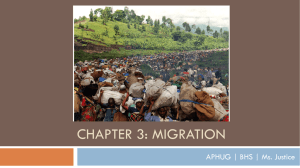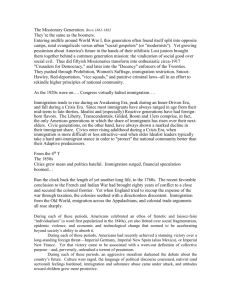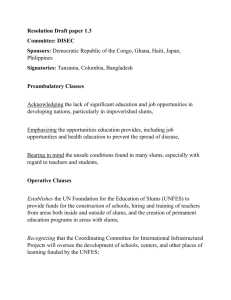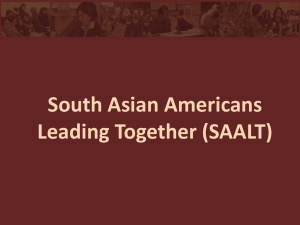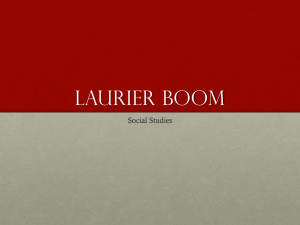25 America Moves to the City
advertisement
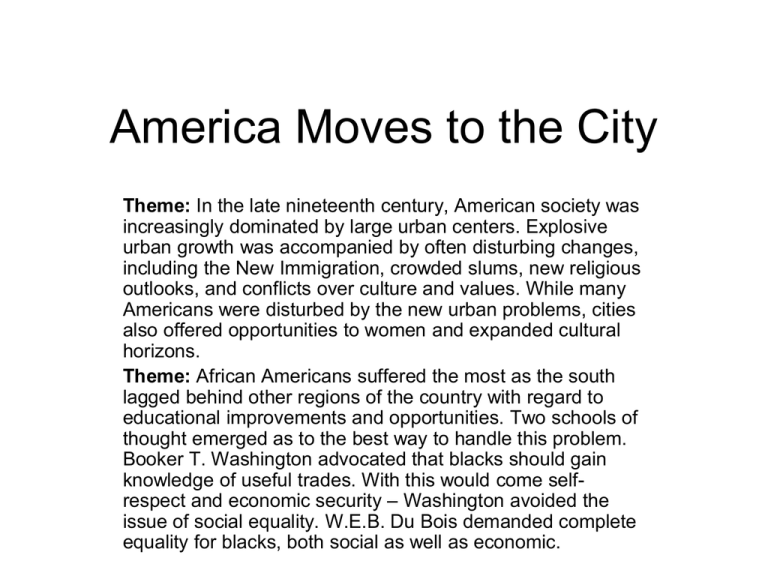
America Moves to the City Theme: In the late nineteenth century, American society was increasingly dominated by large urban centers. Explosive urban growth was accompanied by often disturbing changes, including the New Immigration, crowded slums, new religious outlooks, and conflicts over culture and values. While many Americans were disturbed by the new urban problems, cities also offered opportunities to women and expanded cultural horizons. Theme: African Americans suffered the most as the south lagged behind other regions of the country with regard to educational improvements and opportunities. Two schools of thought emerged as to the best way to handle this problem. Booker T. Washington advocated that blacks should gain knowledge of useful trades. With this would come selfrespect and economic security – Washington avoided the issue of social equality. W.E.B. Du Bois demanded complete equality for blacks, both social as well as economic. I. Rise of the City A. Emigration from farms 1. New technologies a. 2. Appealing lifestyle for some but not others a. b. B. J. Sullivan, electricity, telephones, suburbs Shopping and impact of consumerism Slums, dumbbell tenement, flophouses New Immigration, 1880s 1. Characteristics a. b. c. Southern and Eastern Europe “American Fever” and persecution “birds of passage” II. Reactions to Immigration A. B. Bosses exploitation Nativism 1. 2. C. APA and organized labor Chinese Exclusion Act, 1882 Social reformers 1. 2. 3. D. New York Christian Socialists Middle class targeted urban poor Female reformers pioneered social work as well as other urban employment Religion adjusted to changes 1. 2. 3. •W. Rauschenbusch •Lillian Weld •Florence Kelley Moody, Cardinal Gibbons, Mary Baker Eddy, YMCA Roman Catholic and Judaism gained strength Conflict over evolution divided Protestants Chicago •Jane Adams •Florence Kelley Ohio Washington Gladden’s “social gospel” III. Cultural Challenges Timeline of American Sports • • • • • • • A. Pre-1850’s: Cricket, Boxing, Horseracing, and walking races 1850’s: America’s Cup, Harvard-Yale Regatta (crew), Rugby in England, Montreal lacrosse, Sheffield Soccer, Baseball in NYC, Australian Rule Football in Melbourne, Horse Racing 1860’s: Open Championship (golf), skijumping (Norway), 1870’s: Football in New Jersey, Wimbledon 1880’s: 1st World Series (baseball) 1890’s: French Open (tennis), Stanley Cup (Hockey), Olympic Games, 1900: Rose Bowl (college football), Tour de France, NCAA formed, Compulsory, public-funded Education 1. Public education a. 2. University boom a. B. Accessible libraries Sensationalist newspapers Reform-minded magazines a. b. Edwin Godkin (Nation) Henry George’s land tax! Urbanization stresses families 1. D. Normal Schools and Morrill & Hatch Acts Increased literacy 1. 2. 3. C. Booker T v. Dubois Family statistics reverse Battle for Social Progress 1. Women’s suffrage and NAWSA a. 2. 3. 4. 5. E.C. Stanton, C.C.Catt, I.B. Wells Middle class temperance fears Clara Barton and Red Cross The Realism of Art and Music The rise of Big Business Entertainment Putting Things in Order (Put the following events in correct order by numbering them 1 to 5) 1. _____ Well-educated young midwesterner moves to Chicago slums and creates a vital center of social reform and activism 2. _____ Introduction of a new form of high-rise slum housing drastically increases the overcrowding of the urban poor 3. _____ Nativist organization is formed to limit the “New Immigration” and attack Roman Catholicism 4. _____ The formation of a new national organization signals growing strength for the women’s suffrage movement 5. _____ A western territory becomes the first U.S. government to grant full voting rights to women Answers 1. 2. 3. 4. 5. 4 2 3 5 1






